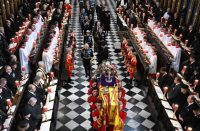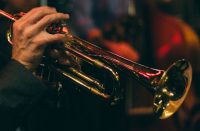
[notice]Hugh Wetmore is a songwriter and student of worship trends. He invites you to join the worship conversation by commenting on his monthly column.[/notice]
The first Christmas Carol was sung from the sky by angels. The words, but not the music, have been preserved for us by Dr Luke, in his Gospel 2:14. “Glory to God in the highest, and on earth peace to men on whom his favour rests.” These words are themed in many subsequent Carols, and their Latin version “gloria in excelsis” is repeated in a number of the carols we will be singing this Christmas.
By definition, a Carol is “a religious seasonal song, of joyful character, in the vernacular and sung by the common people”. In mediaeval Europe it was often accompanied by dancing, and usually sung in the open air. Carols were never profound, but were characterised by simplicity of thought, and rhythmic brightness. Woodward’s “Ding dong! Merrily on High” fits the definition well:
“Ding dong! Merrily on high
in heaven the bells are ringing.
Ding dong verily the sky
is riven with angels singing.
Chorus: Glo…ria, hosanna in excelsis.
E’en so, here below, below,
let steeple bells be swungen,
and i-o, i-o, i-o,
by priest and people sungen!
Chorus: Glo…ria, hosanna in excelsis.
Pray you, dutifully prime
your matin chime, ye ringers;
and may you beautifully rime
your eve-time song, ye singers”
The Christmas Carols of France are called “noels”, which we recognise in such English carols as “The first Nowell the angels did say”. This is one of the Narrative Carols, and you may have noticed that its traditional version says that the SHEPHERDS looked up and saw the star! Biblical accuracy is not a strong point in popular Carols, and recently some of these have been rewritten to conform to the Scriptural account of Christ’s birth (See Jubilate’s amendments to this Carol, in Mission Praise 644).
Some of our Christmas hymns would not have qualified technically as a “carol”, because they are rich in Scriptural allusion, theology and poetic metaphor. Such as “Angels from the realms of glory”, “Once in David’s royal city”, “It came upon a midnight clear”, “Of little town of Bethlehem” and “Hark! the herald angels sing”. But that won’t stop us enjoying their message in our Carol Services this month!
Most mediaeval Carols were passed down in oral song from generation to generation. In 1850 a book was found that had fallen behind an old bookcase, in which a grocer had written the words of Carols popular in the early 1500s. During the 17th century, the Puritans banned Christmas celebrations, and carols with them. But over in Germany they grew more and more popular, climaxing in Christmas Eve sing-alongs. After the Restoration of the English Monarchy 1660, Christmas was celebrated once more, and Carols sung again. They tended to be of poor quality until the mid-1800s, when a movement to write and sing better Christmas songs developed and grew over the next 100 years.
From the middle of the 20th Century, the Renewal Movement, and its more subjective Charismatic Movement sister, began to dominate the international church scene. Hymns began to give way to the Contemporary Worship Music genre. Communication Technology enables its influence to spread at lightning speed all over the world. The band replaced the organ/piano. Fewer musicians could read music, and so learned to play by ear from listening to recorded songs sung by Christian pop-stars. These singers wrote their own music and lyrics. Most of the new songs were simply variations of the same ‘praise and worship’ themes, full of hackneyed feel-good cliches ~ and sung throughout the year, regardless of the occasion or season.
A main casualty has been Christmas songs. The younger generation is not familiar with Carols, and is not encouraged to sing them. Not even those with simple expressions and rhythmic brightness. Fortunately, some contemporary song-writers are correcting this imbalance, and filling this vacuum. Townend and Getty have written some fine Christmas Songs.This November The Gospel Coalition has promoted a beautiful new Christmas Song ~ singable enough to be called a Carol, but meaty enough to not be one! You can listen to it, and download the lyrics and music here. What impressed me about this song is the Partnership between top author and theologian D A Carson and contemporary singer-songwriter Matt Boswell. When you bring together the best of both Biblical Theology and Singable Music, then an outstanding song is born.
So let’s enjoy a SINGING CHRISTMAS, intentionally joining the angels in singing Christmas songs (carols, hymns) about the incarnation and birth of our Lord Jesus, God With Us, the Saviour of the world!






